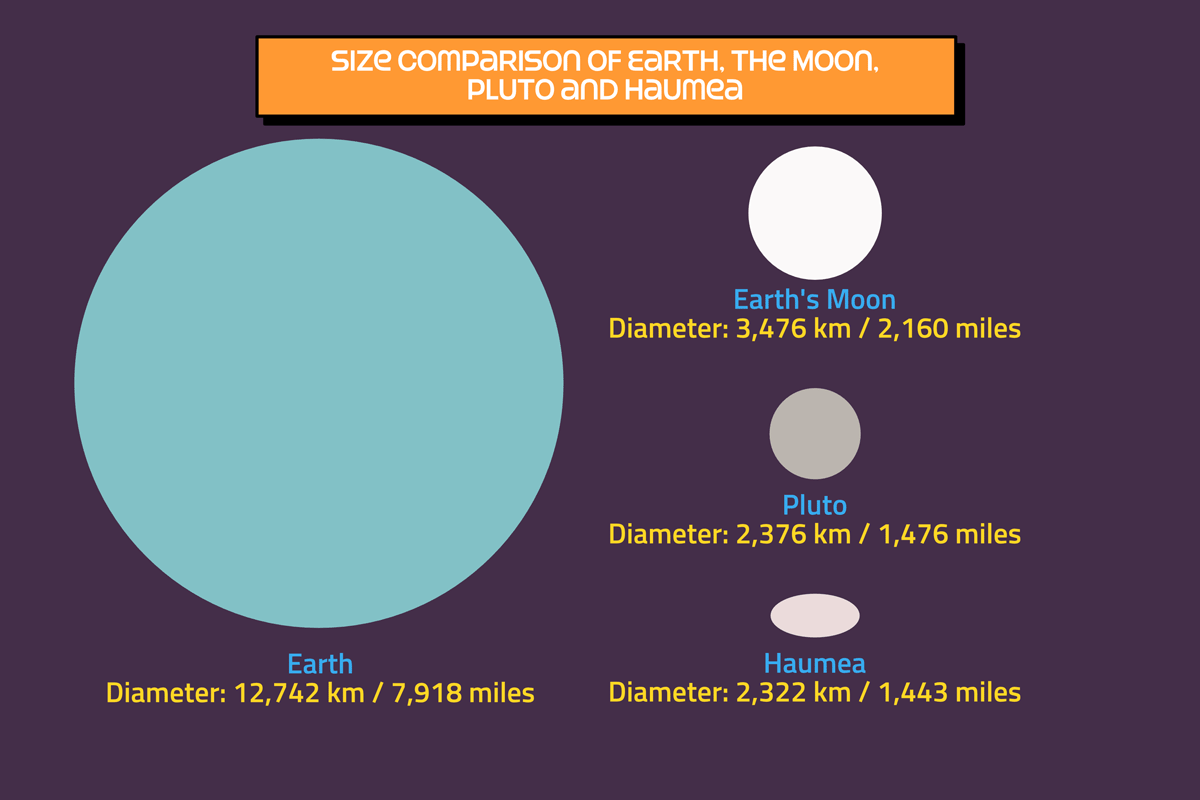Welcome to Haumea!
Situated in the Kuiper Belt beyond Neptune's orbit, Haumea stands out as a distinctive dwarf planet. Haumea has a unique oval shape caused by its rapid rotation. It is named after the Hawaiian goddess of childbirth and fertility and has two known moons. It also has a ring. And its discovery caused a bit of a drama when two teams of astronomers both made claims to have discovered it!
4,007,905,087 miles
43.12 A.U.
(1,443 x 1,059 x 707 miles)
-400 °F
Haumea is one of the Solar System's five recognised dwarf planets, alongside Ceres, Pluto, Makemake, and Eris. All apart from Ceres exist beyond Neptune's orbit so are also classed as Trans-Neptunian Objects. Dwarf planets are bodies that are spherical - or almost spherical - but that, unlike the regular planets, share their orbits with other objects.
Situated in the Kuiper Belt, Haumea orbits the Sun between 5.23 (3.25 billion miles) and 7.7 billion kilometres (4.74 billion miles), taking about 283 years to complete one orbit. Its path is moderately eccentric and tilted relative to the Solar System's plane, and it rotates every 3.9 hours.

Unlike most Solar System objects, Haumea is not spherical but elongated, resembling a rugby ball. This unusual shape is likely caused by its rapid rotation, as centrifugal forces stretch it along its equator. Because of its quick spin and remote location, accurately calculating Haumea's dimensions is not too easy, so current figures are estimates

Haumea is one of the largest known objects in the Kuiper Belt, with its longest axis measuring about 2,322 kilometers. This makes it roughly the same size as Pluto in one dimension, but its unique shape means its volume and mass are significantly less. Haumea's mass is about one-third that of Pluto.

The announcement of Haumea's existence in July 2005 sparked both excitement and controversy among the scientific community. The drama unfolded with two teams of astronomers, one led by Mike Brown in California, USA, and the other led by José Luis Ortiz Moreno in Spain, each claiming the discovery of this distant world.
In December 2004, Mike Brown's team at Caltech in sunny California spotted an unknown object in images taken earlier that year. They nicknamed it Santa because they found it right after Christmas. They decided to hold off announcing their discovery so that they could make further observations of "Santa" and its surroundings, and also because Mike Brown became a dad around that time! This extra time allowed the team to find two moons orbiting "Santa", which they nicknamed Rudolph and Blitzen, and also two additional objects even further out, later known as Eris and Makemake. They uploaded their findings online, and planned a public reveal for later in 2005.
However, before Mike Brown's team could make their announcement, José Luis Ortiz Moreno's team in sunny Spain identified the same object using photographs taken at the Sierra Nevada Observatory back in March 2003. Instead of making their own fresh observations, they used the data posted online by Mike Brown's team to confirm their discovery. They rushed to notify the Minor Planet Center (MPC) about it to stake their claim.
While Mike Brown went on to provide evidence that his team had first observed the object, and highlighted that the Spanish team had used his data for validation, both groups are often recognised for the discovery. The discovery date and location is usually listed as 7th March 2003 at Sierra Nevada Observatory, the site of the earliest recorded observation. Its official name, Haumea, was suggested by Mike Brown's team at Caltech. The object received this name on 17th September 2008 when it was also designated as a dwarf planet. Its two moons received the names Hiʻiaka and Namaka. Haumea is the Hawaiian goddess of childbirth and fertility, while Hiʻiaka is the goddess of Hawaii's Big Island, and Namaka is the Hawaiian goddess of the sea.
Mike Brown's team also brought forward their announcements of Eris and Makemake, possibly to prevent others from getting the scoop on those too.
Your Thoughts?
Who do you think deserves the credit for discovering Haumea? Should it go to the team that first observed it, or the team that first reported it? Is it fair to use another team's data to confirm a discovery? Or should discoveries be shared immediately to foster collaboration among scientists? What do you think?






 AI-generated image of Haumea, giving an idea of its possible appearance based on observations.
AI-generated image of Haumea, giving an idea of its possible appearance based on observations.